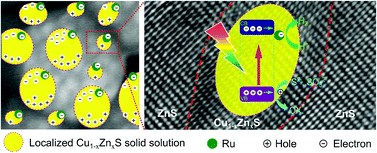Localized nano-solid-solution induced by Cu doping in ZnS for efficient solar hydrogen generation
Abstract
Nanosized photocatalysts have been shown to be important to many modern photocatalytic reactions. Control of the microstructure of the nanocrystals enables regulation of their optical properties and enhancement of specific reactions. Here, Cu2+-doped ZnS nanosphere photocatalysts with hierarchical nanostructures and controllable sizes were synthesized via a facile wet-chemical reaction. We demonstrated that small amounts of Cu2+ doping could give rise to the formation of a variety of localized, nanosized Cu1−xZnxS solid solutions that are separated by a continuous ZnS medium. The nano-solid-solutions have predictable band structures and an average size of several nanometers, which ensure facile generation of electron–hole pairs by visible light irradiation and quick migration of the photo-generated charges to the interfaces. With Ru as a cocatalyst, the as-prepared 0.5 mol% Cu2+-doped ZnS nanospheres showed a high H2 evolution rate of 1.03 mmol h−1, corresponding to a quantum efficiency of 26.2% at 425 nm. A hierarchical surface structure with a large surface area is considered crucial for the increased activity. Our work not only showed that the non-toxic metal chalcogenides achieve high efficiency but also provides a new concept of localized nano-solid-solution for photocatalytic applications.


 Please wait while we load your content...
Please wait while we load your content...